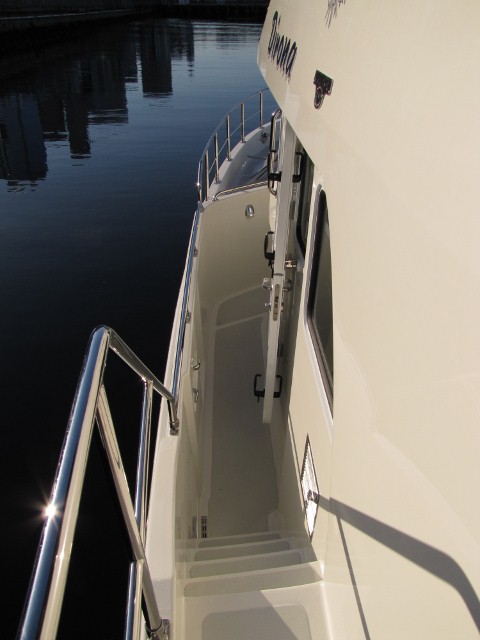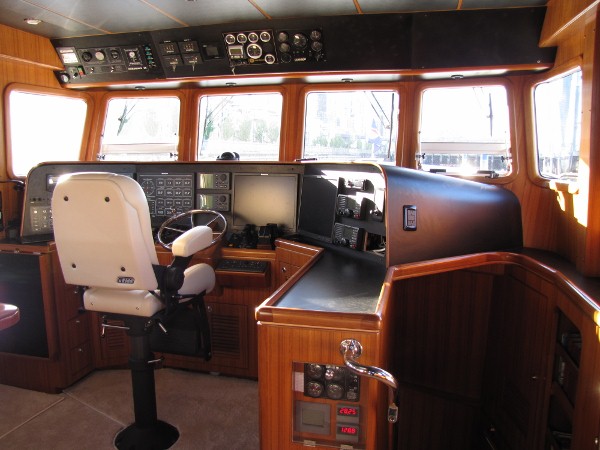Last week we answered this blog comment: Given you have all these changes taking into consideration the PNW waters, I am wondering if you feel you have had to compromise at all on design given you are introducing the idea of taking it out on the open ocean. In other words, one of the things my husband and others have said is that the Nordhavn is designed for Ocean crossing and is “overkill” for someone who just plans to stick around the PNW/B.C. waters.. maybe Alaska. For example …Nordic Tugs or American Tug… are much more OPEN floor plans with wider walk around, etc. I find it very interesting that you have guide books and are tremendously experienced in this area and ended up with this boat. What if you never ended up “Passage making”, would you still be happy you went with a Nordhavn? Some concerns… smaller windows… smaller side decks… more up and down… gosh, wish I was attending your seminar! :-) Thanks! Here’s a more detailed response: Great question, Jackie. We bought the boat because we wanted a safe vessel with ultimate flexibility. It’s exciting to know the boat can go anywhere in the world. If we never leave this area, however, the boat still is ideal for us. The deep draft and weight means the boat doesn’t get tossed around much in big wind and waves. Being out in small craft advisory weather and simply not noticing is a degree of comfort we truly enjoy. And running comfortably in a gale, without stabilizers, is even better. The 52’s draft also gives us a stand-up engine room with plenty of room to work and lots of fuel capacity. We’ve used the boat pretty much every weekend since taking delivery, and love not having to fill the fuel tanks all the time. Our previous boat, a Bayliner 4087, had narrow thigh-height rail-only side decks, similar to the boats you mention. We’d not feel comfortable out there in heavy weather. On the 52, the side-deck is wide, above waist height and covered top and side, allowing for reasonably safe and dry movement outside in rough conditions.
Jackie Schmidt
.jpg)
.jpg)
We can’t ever get more than 4 weeks off work in a year, so going to Alaska is really difficult. With the new boat, we’ve decided that this year we’ll probably make the trip by running 24×7 for just over 4 days up the outside of Vancouver Island and through Hecate Strait. We’d feel less comfortable doing that in a boat that wasn’t so well-built and designed for heavy weather. If we want to bring it around to the east coast, we can do that easily whereas our last boat just didn’t have the range. We had all these crazy plans of going super slow and having two hundred gallons of diesel bladders. But in this boat, instead of the trip being crazy or difficult, we can do it any time.
Even when we’re not traveling during the work week, the boat is enjoyable. The Sub Zero fridge, dishwasher, washer and dryer, heating system, entertainment system etc. make it a really great place to call home. The boat feels bright and airy, with plenty of storage space. We’ve not even come close to filling all the lockers and storage areas, despite living aboard. The stairs give the living areas a bit of separation from the staterooms, making it feel a bit more like a house. With the day head we’ve installed in the salon, there’s a lot less up-and-down anyway. The boat has excellent outdoor living space also–something that was important to us–with room for tables in the cockpit, boat deck and fly bridge.
.jpg) |
.jpg) |
.jpg) |
The more time we spend on the boat and learn the systems, the more we appreciate the attention to detail that goes into it, from both a design and workmanship perspective. This is a boat that will last a long time. The owner’s manual is customized to the boat and incredibly detailed. And as we’ve gotten to know the Nordhavn community better, we’ve learned that many folks are on their second, third or even fourth Nordhavn. That says a lot right there. Although some are travelling the world, many are just enjoying a strong, safe, well-constructed and beautiful boat.
Flexibility to go anywhere is the appeal, but so far all of its use has been in this area and we’re loving it.
.jpg)
Yes, we’ll be around Saturday and we’ll look forward to meeting you folks.
–jrh
jrh@mvdirona.com
Thanks, James, for your excellent responses.
I hope to be up there Saturday with my husband and two boys. You’ll still be around then? I may sneak up there Thursday too by myself, but that is unlikely.
Jackie
Jackie, you are correct that diesel does age. Generally keeping fuel for long periods is discouraged but the problem can be partially mitigated by aggressive fuel polishing.
The Nordhavn community is split on this one. One school recommends only filling the tanks for long trips and maintaining them at low levels otherwise. The other portion of the community recommends keeping the tanks full and using the high quality fuel polishing systems installed on all Nordhavns to keep the fuel clear of water and asphaltenes. Water tends to encourage growth of fungus and bacteria which will plug filters with a black slime. Asphaltenes are heavy products that drop out of diesel with age. The most common choice is to keep the tanks full.
If water is kept out of the tanks by filtration and asphaltenes are not allowed to accumulate, the diesel will last a year at 68F (see http://amsca.com/files/Download/Fuel_news_long_term_storage_diesel.pdf).
We upgraded our filtration system to a very large filter that can flow 1,000 gallons/hour and a pump that puts out 750 gallons/hour and we manage our fuel by transferring all fuel the filter. The most common approach is to gravity feed from the main tanks to the supply tank on a Nordhavn but we choose to not gravity feed and, instead, to only transfer through the filtration system. All fuel that gets to the supply tank has been through at least one filtration recently. Water is drained off frequently. Any of the tanks can be polished. And, we use our boat frequently so we are unlikely to store any fuel for longer than 6 to 9 months in our usage.
The only thing we "miss" about the old boat is that its much smaller. Its easier to find moorage for 40′ boat rather than a 52′ and its easier to work the smaller boat into tight places. But, for full time live aboards, the additional size is, on balance, a positive contribution. The only other potential feature we might miss is speed. The old boat was capable of 17 to 19 kts. But, we never went faster than 14 kts and the new boat can do 9 kts so we really don’t think we are giving up much. The old boat was tiring to run longer than 14 to 16 hours straight whereas the Nordhavn is comfortable running 24×7 so we may actually not be giving up any effective travel distance per day.
Spitfire is very good at staying on the boat in busy marinas. Less good early in the morning when nobody is around. He has a bell on his collar and we keep a very close eye on him and don’t have any non-screened windows open at night.
We will be at Trawlerfest. We will be speaking Thursday and PAE will be showing the boat. Will we see you there?
—jrh
jrh@mvdirona.com
Thanks for the excellent response! I find it very interesting and appreciate you taking the time to answer my questions. I would have responded earlier, but was out of town.
About the fuel tanks… I’ve heard that fuel can "get old". If one isn’t planning on going through a full tank’s worth of fuel quick enough, is it a good idea to just fill it less than full?
Do you miss anything about your old boat?
Do you have any problem with Spitfire (cat’s name?) trying to escape? I had a cat escape our sailboat in middle of the night at Roche Harbor when I was a kid. Amazingly I found him up in the hills.
Are you going to be at Trawlerfest on Saturday?
Jackie